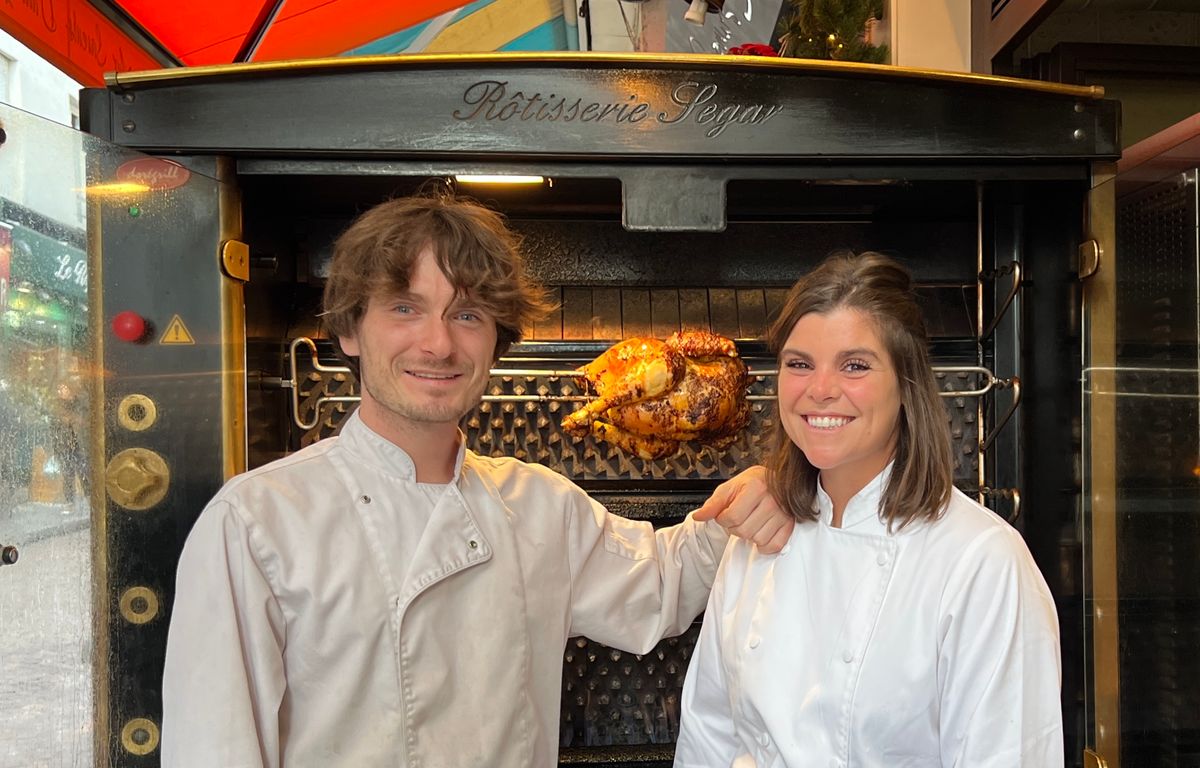
“At Christmas, what do you like to eat? Chestnuts, obviously. So for us, to make a chestnut-based stuffing, we recommend adding something earthy, mushrooms are good, parsley because it’s an herb that goes well with mushrooms, and caramelized onions because that it feels like a little piece of candy. » This is how Victor Seguineau and Elena Araoz, who met on the bands of the Glion hotel school, in Switzerland, talk about their way of accommodating the capon. Stuff the inside so that it does not dry out during cooking.
Last year, the two thirty-somethings opened a rotisserie on rue Mouffetard in Paris called Segar, the contraction of their two names, and quickly made a name for themselves. “Renovate a Viet restaurant in the middle of Mouffe to sell premium roast chickens? Go for Victor Seguineau and Elena Araoz, who are restoring the image of Sunday poultry,” writes Fooding.
For the holidays, Sunday chicken gives way to capon. Beautiful beast of at least 3 kg which deserves to be properly stuffed. “So you don’t have any dispersion of taste because everything stays inside as if you were cooking in a closed casserole dish,” explains Elena.
In their recipe, they put button mushrooms. But you can replace them with oyster mushrooms, chanterelles, or even morels. “But yes,” enthuses Victor, “it’s very good with morels.” » And a little cream? “Yes, to bind a stuffing, you can absolutely put some in it, an egg too. »
The fig capon
The Segar rotisserie offers two other recipes, including one with figs. “And with foie gras,” Elena confirms. Figs, foie gras that we buy already cooked, gingerbread, all deglazed with port. » For this stuffing, you better like sweet and savory mixtures. “Figs are quite sweet,” Victor agrees. Foie gras is quite mild. What will counterbalance is the gingerbread. But when you have fruit, in a recipe, you know what to expect…”
Capon with truffle
Last recipe, capon with Périgord black truffle. In this case, you have to “contise” the capon: slide slices of truffle under the skin. “It’s very delicate work,” explains Victor. We will start with the hand, not with a knife, because you should definitely not pierce the capon’s skin. » “You go through the neck, where the head was cut off,” Elena explains. By grabbing this skin, you will gently lift it up to your thighs. » The couple then begins to add their softened truffle butter. “Very fresh black truffle, not summer truffle which would have less taste here” underlines Elena. And the young woman adds: “you take your little lumps of softened butter, you patch them in strategic places and once it’s done, you re-massage over the skin to spread it well”. “Then, for aesthetics,” explains Victor, “we add small strips of truffle, even if it won’t add any significant flavor. It’s just to make it look pretty. » And inside? No stuffing, but truffle mustard. “We take a classic mustard that we nourish with a little bit of broken truffle and truffle oil,” says Victor. Be careful, you shouldn’t overuse the oil because it can distort the taste of the fresh truffle. But that’s good, because the flesh has to taste like truffles too. And the advantage of putting mustard inside the chest is that the mustard liquefies during cooking and nourishes the flesh from the inside throughout the cooking process. This allows you to have whites that remain juicy. Mustard loses its potency when cooked, so you can use it generously, it will never be as if you had added it raw. » All that remains is to add bay leaf, thyme and “very fresh” rosemary. And voila.
During the holidays, Elena and Victor offer their three capon recipes to order in their rotisserie. From 25.90 euros per kilo. Thirty euros more if you want them to also take care of the cooking.
